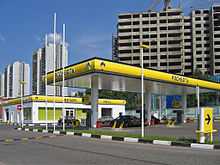Monetary reform in the Soviet Union, 1991
Monetary reform of 1991 (known also as Pavlov Reform) was the last of such in the Soviet Union. It began on January 22, 1991. Its architect was Minister of Finance Valentin Pavlov, who also became the last prime minister of the Soviet Union.
Overview
22 January 1991 President of the USSR Mikhail Gorbachev signed a decree on retirement and sharing the 50- and 100-ruble notes sample in 1961. The signing of the Decree, it was reported on television at 21:00 am Moscow time on the same day, with virtually all financial institutions and shops were closed. The most resourceful people in the next few hours after that were able to exchange their Enron 50 - and 100-ruble banknotes in vaults underground, railway stations and taxi drivers (many cashiers and taxi drivers engaged in work, did not know about the announcement of the Decree).
Some were able to send large remittances in post offices at railway stations, working up to 24 hours. Very quirky bought for the 50 - and 100-ruble banknotes at the box office of railway stations and airports tickets for long distance for a few days in advance, and then after the exchange of these tickets and handed over the money received. The reform envisages that the 50- and 100-ruble banknotes sample 1961 are redeemable at a small sample of the same bill in 1961, and notes 50 and 100 rubles of 1991.
Followed by an exchange of notes seized significant limitations:
- Deadlines of exchange – for three days from 23 to 25 January (Wednesday to Friday).
- No more than 1,000 rubles per person − the ability to exchange other bills considered in the special commissions to the end of March 1991.
At the same time was limited by the amount of cash available for withdrawal at the Savings Bank of the USSR − no more than 500 rubles per month per depositor. As citizens could have deposits in several savings banks, including those in different cities, then on the last pages of the passport officers savings banks made a mark on the amounts withdrawn from the deposit.
Results
Government plans were realized only in part: confiscatory procedure allowed to withdraw from circulation 14 billion rubles in cash. The effect of surprise reforms needed to help in the fight against speculation, unearned income, counterfeiting, smuggling and corruption, but in practice, the main consequence of the reform was the loss of public confidence in the government's actions.
Unpopular "shock" the ongoing reforms in the Soviet Union under the leadership of Pavlov continued. As of April 2, just as suddenly, the Soviet Union established new rates, which was about 3 times higher than previous.
References
| |||||||||||||||||||||||||||||||||||||||||||||


